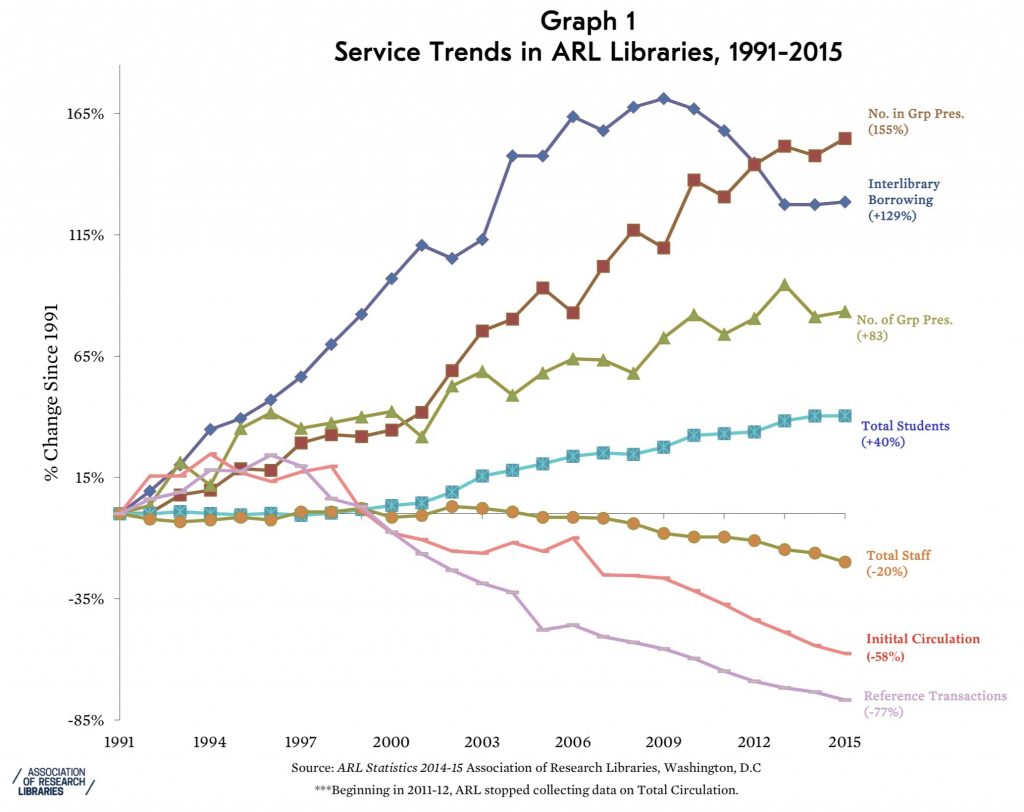I was not expecting—but was gratified to see—an enormous response to my latest piece in The Atlantic, “The Books of College Libraries Are Turning Into Wallpaper,” on the seemingly inexorable decline in the circulation of print books on campus. I’m not sure that I’ve ever written anything that has generated as much feedback, commentary, and hand-wringing. I’ve gotten dozens of emails and hundreds of social media messages, and The Atlantic posted (and I responded in turn to) some passionate letters to the editor. Going viral was certainly not my intent: I simply wanted to lay out an important and under-discussed trend in the use of print books in the libraries of colleges and universities, and to outline why I thought it was happening. I also wanted to approach the issue both as the dean of a library and as a historian whose own research practices have changed over time.
I think the piece generated such a large response because it exposed a significant transition in the way that research, learning, and scholarship happens, and what that might imply for the status of books and the nature of libraries—topics that often touch a raw nerve, especially at a time when popular works extol libraries—I believe correctly—as essential civic infrastructure.
But those works focus mostly on public libraries, and this essay focused entirely on research libraries. People are thankfully still going to and extensively using libraries, both research and public (there were over a billion visits to public libraries in the U.S. last year), but they are doing so in increasingly diversified ways.
The key to my essay were these lines:
“The decline in the use of print books at universities relates to the kinds of books we read for scholarly pursuits rather than pure pleasure…A positive way of looking at these changes is that we are witnessing a Great Sorting within the [research] library, a matching of different kinds of scholarly uses with the right media, formats, and locations.”
Although I highlighted statistics from Yale and the University of Virginia (which, alas, was probably not very kind to my friends at those institutions, although I also used stats from my own library at Northeastern University), the trend I identified seems to be very widespread. Although I only mentioned specific U.S. research libraries, my investigations showed that the same decline in the use of print collections is happening globally, albeit not necessarily universally. In most of the libraries I examined, or from data that was sent to me by colleagues at scores of universities, the circulation of print books within research libraries is declining at about 5-10% per year per student (or FTE).
For example, in the U.K. and Ireland, over the three years between the 2013-14 school year and the 2016-17 school year, the circulation of print books per student declined by 27%, according to the Society of College, National and University Libraries (SCONUL), which represents all university libraries in the U.K. and Ireland. Meanwhile, SCONUL reports that visits to these libraries have actually increased during this period. (SCONUL’s other core metric, print circulations per student visit to the library, has thus declined even more, by 33% over three years.) Similarly, the Canadian Association of Research Libraries (CARL), which maintains the statistics for university libraries in Canada, notes that during these same three years, the average yearly print circulation at their member libraries dropped from 200,000 to 150,000 books, and their per-student circulation number also dropped by 25%.
Again, this is just over three recent years. The decline becomes even more severe as one goes further back in time. In the 2005-6 school year, the average Canadian research library circulated 30 books per student, which slid to 25 in 2008-9; by 2016-17 that number was just 5. Readers of my article were shocked that UVA students had only checked out 60,000 books last year, compared to 238,000 a decade ago, but had I gone all the way back in the UVA statistics to two decades ago, the comparison would have been even more stark. The total circulation of books in the UVA library system was 1,085,000 in 1999-2000 and 207,000 in 2016-17. Here’s the overall graph of print circulation (in “initial circs,” which do not include renewals) from the Association of Research Library (U.S.), showing a 58% decline between 1991 and 2015, but an even larger decline since Peak Book and an even larger decline on a per student basis, since during this same period the student body at these universities increased 40%.

These longer time frames underline how this is an ongoing, multi-decade shift in the ways that students and faculty interact with and use the research library. All research libraries are experiencing such forces and pressing additional demands—the need for new kinds of services and spaces as well as the surging use of digital resources and data—while at the same time continuing to value physical artifacts (archives and special collections) and printed works. It’s a very complicated, heterogeneous environment for learning and scholarship. Puzzling through the correct approach to these shifts, rather than ignoring them and sticking more or less with the status quo, was what I was trying to prod everyone to think about in the essay, and if I was at all successful, that’s hopefully all to the good.